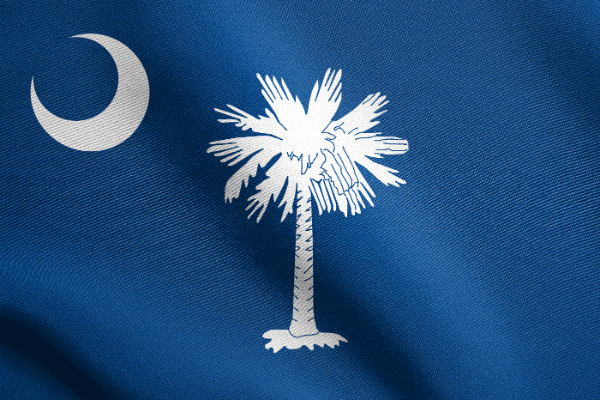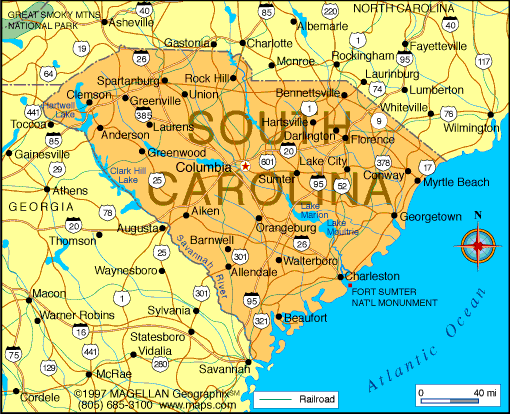South Carolina

South Carolina State Facts
Entered Union: May 23, 1788 (8th State)
Present constitution adopted: 1895
Fun Facts
State abbreviation/Postal code: S.C./SC
Nickname: Palmetto State
Origin of name: In honor of Charles I of England
Mottoes: "Animis opibusque parati" (Prepared in mind and resources) and "Dum spiro spero" (While I breathe, I hope)”
State symbols:
Amphibian: Spotted salamander (1999)
Animal: White-tailed deer (1972)
Bird: Carolina wren (1948)
Butterfly: Eastern tiger swallowtail (1994)
Dog: Boykin Spaniel
Duck: Wood duck (2009)
Fish: Striped bass or rockfish (1972)
Heritage Horse: Carolina Marsh Tacky (2010)
Heritage Work Animal: mule (2010)
Insect: Carolina mantid (1988)
Marine Mammal: Bottlenose dolphin (2009)
Migratory Marine Mammal: Northern right whale (2009)
Reptile: Loggerhead sea turtle (1988)
Shell: Lettered olive (1984)
Spider: Carolina wolf spider (2000)
Wild Game Bird: Wild turkey (1976)
Grass: Indian grass (2001)
Flower: Yellow jessamine
Fruit: Peach (1984)
Tree: Sabal palmetto (1939)
Wildflower: Goldenrod
Fossil: Columbian mammoth (2014)
Gemstone: Amethyst (1969)
Stone: Blue granite (1969)
Beverage: Milk (1984)
Color: Indigo blue (2008)
Craft: Sweetgrass basket weaving
Hospitality Beverage: Tea (1995)
Snack: Boiled peanuts
Dance: Shag (1984)
American Folk Dance: Square dance (1994)
Waltz: "Richardson Waltz" (2000)
Music: Spiritual (1999)
Popular Music: Beach music (2001)
Government
Capital: Columbia
State website: https://www.mass.gov/
Governor: Henry McMaster, R (to Jan. 2023)
Lieut. Governor: Pamela Evette, R (to Jan. 2023)
Secy. of State: Mark Hammond, R
Treasurer: Curtis Loftis, R
Atty. General: Alan Wilson, R
U.S. Representatives: 7
Senators: Lindsey Graham, R (to Jan. 2021); Tim Scott, R (to Jan. 2023)
See Also: Historical biographies of South Carolina Congress members
Population
Residents: South Carolinian
2016 resident population: 4,961,119 (23rd Largest State, 2016)
10 largest cities (2010 est.): Columbia, 129,272; Charleston , 120,083; North Charleston, 97,471; Rock Hill, 66,154; ; Greenville, 58,409; Sumter, 40,524; Florence 37,056, Spartanburg, 37,013; Goose Creek, 35,938; Aiken, 29,524
Race/Ethnicity: White (66.2%); Black (27.9%); American Indian (0.4%); Asian (1.3%); Other race (2.5%); Two or more races (1.7%); Hispanic/Latino: (9.6%).
Religion: Protestant (65%); Unaffiliated (19%); Catholic (10%); Other Christian (3%); Other (3%)
Sex: Male (48.6%); Female (51.4%).
Age: Under 18 (22.0%); 18-64 (60.8%); 65 and over (17.2%). Median Age: 39.1
See Also: Additional South Carolina Census Data
Economy
GDP: 219 billion dollars (26th in U.S., 2017)
Unemployment: 3.8% (2017)
Overview: South Carolina, like most states, has a primarily service-based economy. In recent years, a substantial amount of economic growth in the state has come from an improving industrial base, including the construction of manufacturing plants for major companies like Boeing. The state otherwise maintains a strong agricultural sector, producing goods like tobacco, rice, cotton, and soy, as well as livestock like cattle and chickens.
Geography
Land area: 30,109 sq mi. (77,982 sq km)
Geographic center: In Richland Co., 13 mi. SE of Columbia
Number of counties: 46
Largest county by population and area: Greenville, 451,225 (2010); Horry, 1,134 sq mi.
State forests: 4
State parks: 47 (80,000+ ac.)
Area codes
Tourism office
See more on South Carolina:
Encyclopedia: South Carolina
Encyclopedia: Geography
Encyclopedia: Economy
Encyclopedia: Government
Encyclopedia: History
Monthly Temperature Extremes
South Carolina State History
The earliest history of South Carolina is similar to a lot of the Eastern United States; it was populated 13,000 years ago by archaic communities, which went on to follow the same big changes that affected most cultures in the area. By the time of European contact there were 29 nations of native people in South Carolina. The nations of South Carolina mostly fell under two large culture groups, the Eastern Siouan and Cusaboan peoples, though other groups lived in the area.
Following exploration of the coast in 1521 by Francisco de Gordillo, the Spanish tried unsuccessfully to establish a colony near present-day Georgetown in 1526, and the French also failed to colonize Parris Island near Fort Royal in 1562. Although there was an older charter from 1629, King Charles II of England chartered the colony in 1663 to wealthy aristocrats in exchange for their political support back in England. The colony was named Carolina after King Charles, and it acted as a buffer zone between Spanish territory and the other English colonies. The first English settlement was made in 1670 at Albemarle Point on the Ashley River, but poor conditions drove the settlers to the site of Charleston (originally called Charles Town).
South Carolina, officially separated from North Carolina in 1729. Charleston, despite its size and influence in the colonies, wasn't incorporated until after the Revolution. The city was run by a governor representing the Crown, and the state was a bastion of Loyalism to the British government. It was the scene of extensive military action during the Revolution and again during the Civil War.
In the 1800s, South Carolina played a leading role in Southern hostility to the federal government, and in the entrenchment of slavery in the Deep South. South Carolina was the largest slave state by percentage of people in slavery, and had the strictest laws toward freeing slaves; the government worked hard to ensure the dominance of the minority white population over the black majority (related, the huge Black population is credited with the preservation of African traditions in the Carolina Lowcountry). In 1832 this contributed to the Nullification Crisis. In 1861, South Carolina became the first state to secede from the Union. The Civil War began in 1861 as South Carolina troops fired on federal Fort Sumter in Charleston Harbor.
After the Confederate loss in the Civil War, South Carolina became the only state with a black majority congress. This saw a brief period of rapidly expanding rights for Black Americans that was swiftly reversed during the Jim Crow era. However, despite its long history as a bedrock slave state, South Carolina didn't see the levels of violence that plagued Mississippi and Alabama during desegregation. Likewise South Carolina was relatively swift among former Confederate states to remove the Confederate flag from government buildings after incidents of racial violence.
Historic points of interest include Fort Sumter National Monument, Fort Moultrie, Fort Johnson, and aircraft carrier USS Yorktown in Charleston Harbor; the Middleton, Magnolia, and Cypress Gardens in Charleston; and Cowpens National Battlefield. VIsitors might also be interested in the Hilton Head resorts, and the Riverbanks Zoo and Botanical Garden in Columbia.
South Carolina Culture and Interesting Facts
Myrtle Beach & the Grand Strand
Myrtle Beach is likely South Carolina's biggest tourist attraction, as the center of the Grand Strand string of beaches. The beaches collectively draw over 14 million visitors every year—that's nearly three times the population of South Carolina—and Myrtle Beach specifically hosts a lot of famous attractions. The recently opened boardwalk, the nearby Family Kingdom Amusement Park, and the abundant shopping have led Myrtle Beach to receive regular national acclaim. That's a pretty big achievement, considering the town used to be almost entirely off the map. The idea to develop the beach into a tourist area only started in the early 1900s, and the city of Myrtle Beach was only incorporated in the 1950s.
Charleston, South Carolina
The city of Charleston is one of the most historically important cities in the United States. It was one of the first major cities in the country, founded back in 1680, and was at one point the fifth largest city in the nation. For rather unsavory reasons, the city continued to have an outsize influence on the country even as the rest of the country grew and expanded; Charleston was the largest slave port in the United States, sometimes second to Savannah, Georgia. The slave trade in Charleston led to South Carolina being the state with the largest Black majority population and being the only state with a majority of legislators being slaveholders. The Civil War started in Charleston when secessionists attacked Fort Sumter. Today the city is famous for much nicer reasons, including its lovely and well-preserved architecture, its food culture, and its healthy arts scene. The city has received international attention and praise as a tourist destination.
South Carolina Plantations
The plantations of South Carolina are another popular tourist destination. The plantations were home to the aristocratic elite, who built large country mansions in which to live comfortably as they profited off the forced labor of slaves. These former slaveholding mansions embody a lot of important history in the South. They offer a glimpse into the historic culture of the area including the artistic tastes and values of the slaveholding class, the economic realities that shaped American history, and the violent injustices inflicted on America's Black population. Some plantations are just catered to tourists interested in the design and art, but many of the best plantation museums allow visitors to dive into the deep history of slavery in the United States.
Gullah Culture in the Lowcountry
Gullah culture refers to the unique culture of Black people living in the Lowcountry of South Carolina and Georgia. Gullah people are most culturally distinct from other Black Americans due to their use of their own creole language, also called Gullah, which heavily draws on different West and Central African languages. South Carolina was a Black-majority state, and more than anywhere else Gullah culture has heavily influenced the whole of South Carolina. The unique style of Gullah art and cuisine makes up some of South Carolina's most powerful cultural legacy. One particular type of art (or craft), Sweetgrass basket weaving, was recognized as a symbol of the state.
Famous South Carolina Natives and Residents
Bernard Baruch statesman;
Mary McLeod Bethune educator;
James F. Byrnes senator, jurist and secretary of state;
John C. Calhoun statesman;
Mark Clark general;
Pat Conroy writer;
Shepard Fairey artist;
Joe Frazier prize fighter;
Althea Gibson tennis champion;
Dizzy Gillespie jazz trumpeter;
DuBose Heyward poet, playwright, and novelist;
Andrew Jackson president;
Jesse Jackson civil rights leader;
Eartha Kitt singer;
Francis Marion ("Swamp Fox") Revolutionary general;
Mary-Louise Parker actor;
John Rutledge jurist;
Strom Thurmond politician;
Charles Townes physicist;
William Westmoreland general;
Vanna White TV personality

